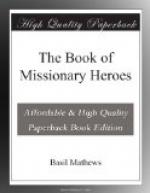For instance, when a man was “ragging” him in the College Hall at dinner, he was so furious that he flung a knife at him, which stuck quivering in the panelling of the wall. Kempthorne, his old friend, was at Cambridge with him. They used to read the Bible together and Martyn became a real Christian and fought hard to overcome his violent temper.
He was a very clever scholar and became a Fellow of Jesus College in 1802. He at that time took orders in the Church of England. He became very keen on reading about missionary work, e.g. Carey’s story of nine years’ work in Periodical Accounts, and the L.M.S. Report on Vanderkemp in South Africa. “I read nothing else while it lasted,” he said of the Vanderkemp report.
He was accepted as a chaplain of the East India Company. They could not sail till Admiral Nelson gave the word, because the French were waiting to capture all the British ships. Five men-of-war convoyed them when they sailed in 1805. They waited off Ireland, because the immediate invasion of England by Napoleon was threatened. On board Martyn worked hard at Hindustani, Bengali and Portuguese. He already knew Greek, Latin and Hebrew. He arrived at Madras (South India) and Calcutta and thence went to Cawnpore. It is at this point that our yarn begins.
A voice like thunder, speaking in a strange tongue, shouted across an Indian garden one night in 1809.
The new moon, looking “like a ball of ebony in an ivory cup,”—as one who was there that night said—threw a cold light over the palm trees and aloes, on the man who was speaking and on those who were seated around him at the table in the bungalow.
Beyond the garden the life of Cawnpore moved in its many streets; the shout of a donkey-driver, the shrill of a bugle from the barracks broke sharply through the muffled sounds of the city. The June wind, heavy with the waters of the Ganges which flows past Cawnpore, made the night insufferably hot. But the heat did not trouble Sabat, the wild son of the Arabian desert, who was talking—as he always did—in a roaring voice that was louder than most men’s shouting. He was telling the story of Abdallah’s brave death as a Christian martyr.[62]
Quietly listening to Sabat’s voice—though he could not understand what he was saying—was a young Italian, Padre Julius Caesar, a monk of the order of the Jesuits. On his head was a little skull-cap, over his body a robe of fine purple satin held with a girdle of twisted silk.
Near him sat an Indian scholar—on his dark head a full turban, and about him richly-coloured robes. On the other side sat a little, thin, copper-coloured Bengali dressed in white, and a British officer in his scarlet and gold uniform, with his wife, who has told us the story of that evening.
Not one of these brightly dressed people was, however, the strongest power there. A man in black clothes was the real centre of the group. Very slight in build, not tall, clean-shaven, with a high forehead and sensitive lips, young Henry Martyn seemed a stripling beside the flaming Arab. Yet Sabat, with all his sound and fury, was no match for the swift-witted, clear-brained young Englishman. Henry Martyn was a chaplain in the army of the East India Company, which then ruled in India.




